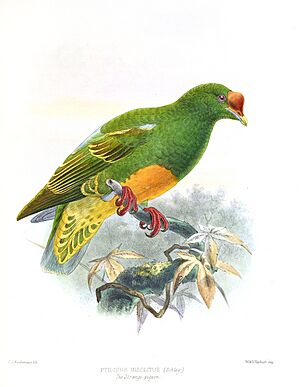Knob-billed fruit dove facts for kids
Quick facts for kids Knob-billed fruit dove |
|
|---|---|
 |
|
| Conservation status | |
| Scientific classification | |
| Genus: |
Ptilinopus
|
| Species: |
insolitus
|
| Synonyms | |
|
|
The knob-billed fruit dove (Ptilinopus insolitus) is a special type of bird. It belongs to the Columbidae family, which includes doves and pigeons. This unique bird is found only in the Bismarck Archipelago, a group of islands near Papua New Guinea. It gets its name from a small, knob-like growth on its beak.
Contents
What's in a Name? Understanding the Knob-billed Fruit Dove's Identity
Scientists use a system called taxonomy to name and group all living things. This helps us understand how different species are related. The knob-billed fruit dove was first described by a scientist named Hermann Schlegel in 1863. He gave it the scientific name Ptilopus insolitus.
Unpacking the Scientific Name: Ptilinopus insolitus
The first part of its scientific name, Ptilinopus, comes from ancient Greek words. "Ptilon" means feather, and "pous" means foot. This might refer to the soft feathers on the bird's feet. The second part, insolitus, is a Latin word meaning "strange" or "unusual." This probably describes its unique knob-like beak.
The official common name for this bird is the knob-billed fruit dove. This name was chosen by the International Ornithologists' Union. Sometimes, people also call it the red-knobbed fruit dove or Schlegel's fruit-dove.
Family Ties: Relatives of the Knob-billed Fruit Dove
The knob-billed fruit dove has some close relatives in the bird world. It is thought to be part of a special group of fruit doves. This group includes the orange-bellied fruit dove, the grey-headed fruit dove, and the carunculated fruit dove. Other possible relatives are the black-naped and dwarf fruit doves.
Different Types: Subspecies of the Knob-billed Fruit Dove
Even within the same species, there can be slight differences depending on where they live. These variations are called subspecies. The knob-billed fruit dove has two recognized subspecies:
- Ptilinopus insolitus insolitus: This is the main subspecies. It lives across most of the Bismarck Archipelago.
- Ptilinopus insolitus inferior: This subspecies is found on Mussau and Emirau. It is smaller than the main subspecies. It also has reddish-brown feathers around a grey patch on its shoulder. Some scientists think this might even be a separate species!


